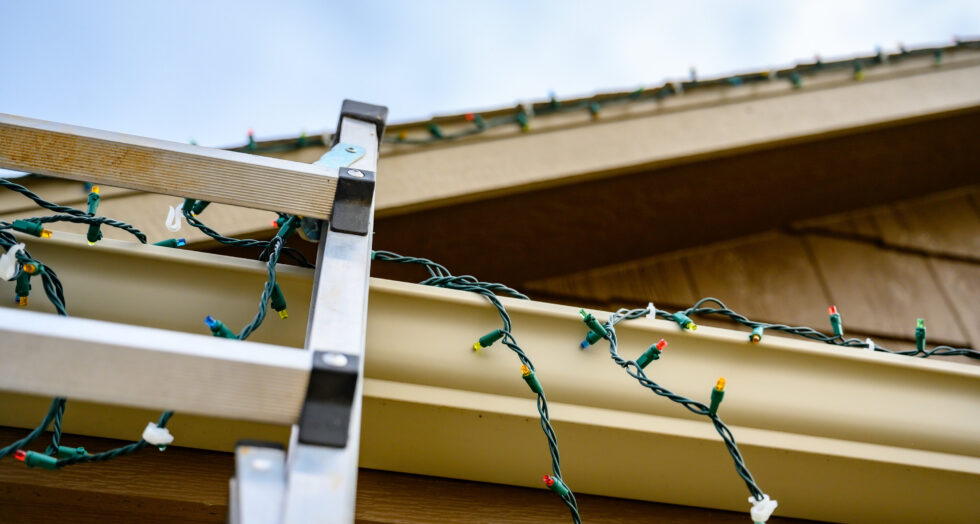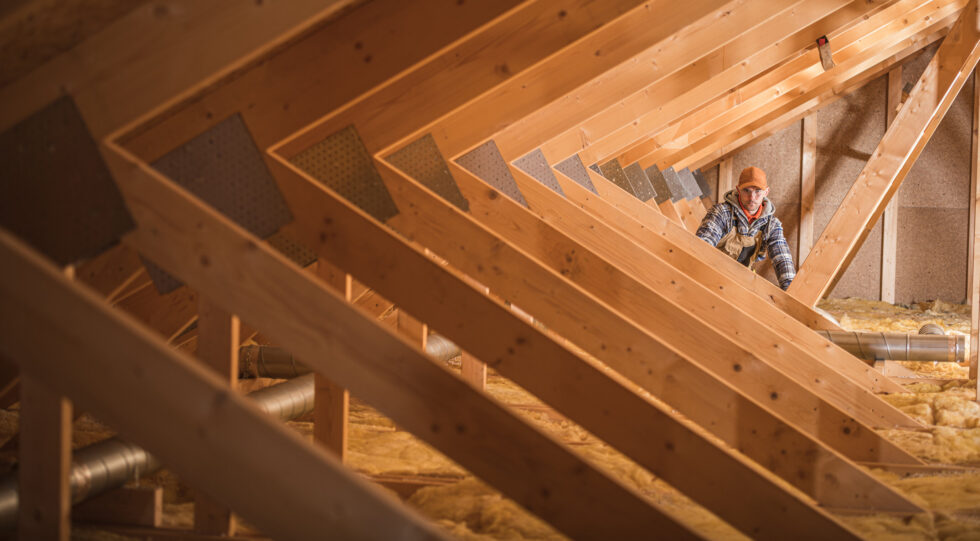Can I Hang Lights From My Roof for the Holidays?

It’s almost that time of year again. Hanging holiday lights and watching your home glow is one of the greatest pleasures of the season. Almost everyone decorates their houses with magnificent holiday lights these days, with some people boasting impressive displays beyond our wildest imaginations.
However, while it may seem pretty simple to string some fairy lights from your roof, if not done properly, it can cause damage. That’s right, there’s a correct and proper way to hang holiday lights. Here are some tried and tested tips and tricks that will help your home look festive without leading to a leaky roof!
Make A Plan
Plan out exactly where you’re going to hang your lights before you start doing so. It’s important to have an idea in mind rather than just winging it. There might be some areas of your roof that are dangerous or precarious to get to, and those should be avoided. Try taking a photo of your home and using that as a map for where you want to hang your lights. Making a good plan will also prevent too many unnecessary trips up and down the ladder!
Prepare Your Home
Before getting started, you first and foremost need to know exactly what length of string lights you will need. You might require more than you think, as working around corners and windows can be deceptive. Measure the total length of the space you wish to decorate, including the roofline, gutters, windows, and doorframes, before going out to purchase your lights.
Pick The Best Lights
If you’re using old string lights, check them for wear and tear. Don’t use lights with frayed or damaged cords or exposed wires. When purchasing lights, double-check to make sure they’re the color you want. There are different types of white light, with some being significantly brighter than others. LED lights are also the most cost-effective and long-lasting option. Lastly, make sure any lights you purchase are specifically designed for safe outdoor use.
Use the Right Materials
This might go without saying, but don’t use sharp materials such as nails and staples to fix lights on your roof. It’s not a good idea to use anything that can cause damage to your roof or expose it to the elements.
Holes in your roofing, even the tiniest ones caused by a staple gun, can open up the interior of your home to moisture and damage. These are the enemies of a roof, so avoid those sharp objects! These days, it’s easy to find plastic light clips specifically designed for hanging holiday lights. Pick up some of those while you’re at the store, your roof will thank you for it.
Get to Work
For a flawless look, attach your light clips every 6 to 10 inches apart to avoid that sad, sagging look. If you want your light job to look flawless, keep it crisp and clean. Secure the lights firmly and face them all in the same direction. Work neatly around doors and window frames. If you need to attach lights to posts or railing, zip ties are a great, safe option that won’t damage anything.
What NOT To Put On Your Roof
Lights are beautiful and, if installed correctly, safe. However, some people like to go all out for the holidays. We all have that one neighbor who has every type of light and decoration available. While it might look impressive to have a house and yard that looks like it belongs to Santa himself, not all decorations are safe, particularly for the roof of your home.
Steer clear of putting any type of decoration near the chimney. All it takes is one stray ember and you’ll have a house fire on your hands. It’s also ill-advised to cover your roof in those flashy inflatable decorations. Sure, they might look awesome, but consider this. One big gust of wind combined with a poorly fixed inflatable snowman and your roof is going to be suffering from some serious damage! Lastly, avoid covering your roof in heavy decorations. That life-size Rudolph replica might look appealing, but adding lots of heavy decor t your roof, combined with the weight of snow and ice, is a recipe for disaster.
Should My Roof Be Insulated?


Those who are building or renovating their homes often wonder whether roof insulation is worth the money. It’s not always standard to install insulation directly into the roof slope itself, begging the question of necessity for many homeowners.
Proper roof insulation might not be seen in all houses, but it does have advantages. Not only does it prevent unnecessary damage, but it also stops you from racking up serious heating and cooling costs during extreme weather. Poor or non-existent insulation is very expensive because of the amount of energy being wasted trying to keep a home at an ideal temperature.
However, many homes don’t have roof insulation, and rather have just ceiling insulation. This is quite common, and under some circumstances can work well, rendering roof insulation in addition to an insulated ceiling unnecessary.
What’s The Difference Between Roof and Ceiling Insulation?
Roof insulation refers to the insulating of the actual roof slope itself. Ceiling insulation, however, is the installation of any type of insulation in the floor nearest the roof structure. Insulating a ceiling is significantly easier, and sometimes cheaper, than a roof, which is why if you have to choose between one or the other, ceiling insulation might be the better option.
That being said, there are some circumstances where your roof must have insulation. For example, any home where the ceiling is a part of the roof deck, like with cathedral ceilings, will require roof insulation to regulate the internal temperature of the house.
If ceiling insulation is necessary or preferred for your home, there are multiple types of ceiling insulation to choose from including:
- Fiberglass
- Cellulose
- Foam
- Spray Foam
- Mineral Wood
- Natural fiber
- Denim insulation
What is Roof Insulation?
If you like in an area where temperatures reach either hot or cold extremes regularly, you can’t be too careful with your insulation. In these conditions, roof insulation is recommended, and is typically constructed from the following materials:
- Fiberglass Batt Insulation: This is by far the most common and inexpensive method, and involved the placement of fiberglass sheets in between attic rafters. However, this material isn’t the best at preventing air leakage and is also highly susceptible to unhealthy mold and mildew growth.
- Rigid Foam Insulation: Another common insulation material, rigid foam comes in sheets or panels that can be specifically sized to fit the roof slope. These panels can be installed between roofing rafter and also create an effective barrier t protect your home from air leaks and damp conditions.
- SPF (Spray Foam Insulation): Similar to fiberglass insulation, this material is sprayed between the attic rafters to form a seamless barrier against leaking air and moisture. Because of this, Spray Foam Insulation is a fantastic option for the conversion of an attic or anywhere where the roof directly protects a living space.
The advantages of roof insulation
A properly sealed attic or well-installed insulation in a roof is much more efficient in terms of energy. A roof is a very large surface area, and can easily lose heat during the winter if not properly insulated. Roof insulation will also make your air conditioning significantly more effective in the hot summer months.
Having your roof insulated can also work wonders in preventing any long-term damage from ice dams, condensation, or moisture. If you live in a very cold climate, roof insulation is typically a must. Freezing conditions are very damaging to a poorly insulated roof and can lead to expensive repairs. Whatsmore, roof insulation, and proper ventilation work together to help keep your home free protected, and damage-free.
Although installing roof insulation might be costly in the beginning, it will certainly save you money in the long run. Roof insulation significantly increases the energy efficiency of a home. Not to mention protects your roof from damage caused by cold conditions and ice. Such damage can be exorbitant to repair, so forking out the upfront cost for the installation of roof insulation is advisable.

